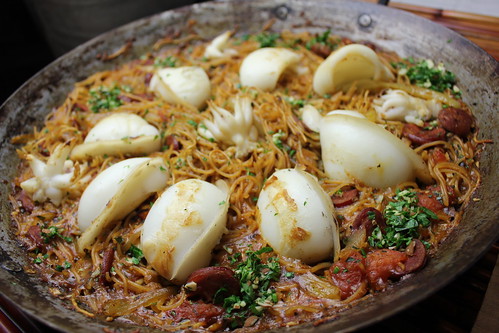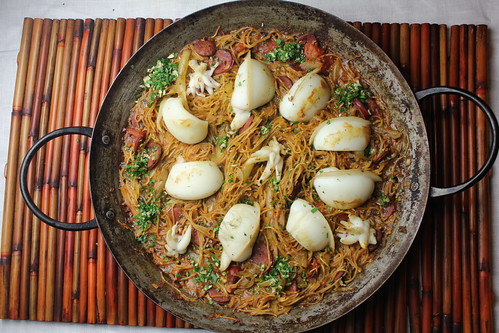For centuries, mankind and cuttlefish have had something of a difficult relationship, certainly from the latter’s perspective. Even prior to the development of the photographic tint known as sepia – a brownish hue that makes the late 19th century appear to have been an unusually dusty period – the ink of the cuttlefish was prized for its color-giving properties. In fact, this cephalopod’s dye is known as ink because that is exactly what much of recorded history was written in.
In an ironic twist, the plight of the cuttlefish worsened when enterprising fisherman saw that the inedible, but highly buoyant, internal structure, known as cuttlebone, could be used to manufacture floats which, when attached to fishing lines, resulted in an even more effective means of catching them. The concurrent discovery that the rest of the poor creature is exceedingly delicious, like a meatier version of squid, only increased humanity’s murderous desire, making its existence almost untenable in some parts of the Mediterranean until synthetic dyes and plastic floats allowed populations to recover in recent times.
In the same general spirit of fishermen making the best use of what they had to hand, it is thought that fideua, a noodle dish cooked in a similar fashion to paella, was the fortuitous outcome of an absent-minded fishing boat’s cook having left his bag of rice ashore sometime in the 1920s. This dish is now popular throughout Mediterranean Spain, but the beach resort of Gandia claims it as its own, styling itself as the “Home of the Fideua” (pronounced roughly “fih-day-wah”). [For more on Gandia, as well as some interesting podcasts on life in Spain, click here.]
And it is little wonder that neither this fisherman nor his countrymen have looked back since discovering the dish. It is as perfect for a quick weeknight meal as it is enjoyed lazily on a summer weekend. Unfortunately, and it’s not clear why, since squid is very popular in the US, cuttlefish doesn’t seem to have caught on this side of the Atlantic and is consequently rather tricky to source. That is, of course, one knows about the wonderful web store, La Tienda, who were kind enough to send us a couple of pounds of delicious Peregrino Canarian sepia recently.
La Tienda PR and marketing manager, Laurie Hager, reached out to us after she’d read our (admittedly pretty fabulous) pork belly pincho moruno post over on the Christian Science Monitor and leafed through a couple of our other posts on Spain – including this one featuring a terrible picture of some very fine cuttlefish a la plancha we ate in Madrid, deciding very correctly that we were worthy recipients of gratis merchandise. Let it be known that we would have posted about this sooner had we not moved house six weeks ago and only just started eating homemade food again after several unhappy weeks eating out of cans as we slowly unpacked our cooking gear.
Let it also be known that La Tienda is seriously committed to sourcing authentic Spanish products for us Americans. Such is their devotion, that La Tienda founder, Don Harris, was recently awarded Spain’s cross of the order of civil merit for his services in promoting the people, culture and foods of Spain in America. Here’s hoping that this post and the body of our work on this site dedicated to Spanish gastronomy helps, even in a small way, La Tienda go from strength to strength.
Ingredients
- 1x7oz package fidelini/fideos or similar wheat noodle pasta nests, angel hair is a good substitute
- 1lb cleaned cuttlefish (sepia/choco), bodies and tentacles separated, and patted dry with paper towels
- 2 small (or 1 large) dry chorizos, cut into 1/2 inch cubes
- 1 yellow onion, diced
- 4-6 cloves garlic, finely chopped
- 1 green bell pepper/capsicum, or variety of your favorite sweet peppers, finely chopped
- 2 pints/1 quart/1 liter good quality fish or vegetable stock (hot water is fine too)
- 1 teaspoon sweet paprika (pimenton dulce)
- 1/2 teaspoon hot paprika (pimenton picante)
- 2-3 tablespoons olive oil
- 1/2 cup white wine
- 3-4 teaspoons (1 handful) finely chopped flat-leaf/Italian parsley
- 2 teaspoons finely chopped almonds
- kosher salt
Recipe
- Preheat boiler to high and position oven rack one below the highest level.
- Chop half the garlic, all the parsley and all the almonds together with a pinch of salt and a dash of olive oil to make a picada.
- In a large wide, oven-safe saucepan or paella pan, heat olive oil to medium and add chorizo, peppers and onions.
- Saute until onions are translucent and chorizo has given up plenty of orange fat. Add half the garlic.
- Allow garlic to soften for another 2-3 minutes, before adding both kinds of paprika.
- Stir well and cook another minute or so before increasing heat to high and adding the wine.
- Allow wine to reduce by half before placing noodle nests around the pan amongst the onions, chorizo and garlic.
- Add most of the stock, reserving about a cup without disturbing the noodles. Then add the cuttlefish/sepia, placing it around the noodle nests. Cook on high, simmering the stock, for about five minutes until noodles start to wilt and liquid is reduced by about 3/4.
- Give noodles a poke. If they still feel firm, add the remaining stock. If they’re getting towards cooked, add the garlic, parsley and almond picada and stir gently. Then place pan under the broiler.
- (if your noodles were still firm in step 9, you should wait until they’re almost cooked before putting pan under the broiler.
- Keep your eye on it and watching it carefully for burning noodles, wait until almost all of the liquid has been absorbed. The noodles and the cuttlefish should now be starting to get brown and crispy on top, depending on your broiler, this could take anywhere from 3-10 minutes.
- Serve immediately.


Oh, I love fideua. And I love cuttlefish–on our last trip to Spain we ate it as often as we could given the difficulty in finding it here, but I had no idea La Tienda sold it frozen. How did you find the texture and flavor once it was cooked?
@Elizabeth: Thanks for stopping by – I know you’ve recently returned from Spain so this is right in your wheelhouse right now. The texture is extraordinarily succulent if you cook it right, but rather like squid it can be overcooked and rubbery all too easily. The flavor is also somewhat squid-like, but I would say that it’s squid on steroids. Not in the sense of it being overpowering, but squid can be a canvas for whatever is going with it, whereas sepia has enough flavor to carry a dish by itself.
Well done!
I swear you were a Spaniard in another life. You have such an affinity for the food of the motherland and all it’s former colonies!
Love La Tienda!
Hi, Joan! Now with having a little one, cooking Spanish food really is the only way to feel like we have traveled… anywhere! Thanks so much for the comment (and to continue to read our posts even after we haven’t posted for months!) You’re the best… happy thanksgiving!
Thanks J&A! I definitely want to try ordering these guys, but I want to save this for a special occasion, I think.
Hi
Have found your page by accident and first I saw was that amazing dish.
I love cuttlefish..yours looks sooo good!
have to give a try one time!!!!!
C.